HR7005: Analyzing Organizational Development and Change Management
VerifiedAdded on 2023/06/18
|10
|3100
|154
Report
AI Summary
This report provides an analysis of organizational development (OD) and change management, examining historical and standard organizational structures, managerial changes, and the role of Human Resources in facilitating OD. It discusses the five-step OD framework including anticipating the need for change, client relationships, diagnostic phase, action plans, and self-renewal/stabilization. The report further explores the HR requirements for OD, such as performance management, talent development, selection diversity, and employee assistance programs, emphasizing the importance of rational behavior. A critical analysis of OD is presented, considering competitive analysis, strategic management, and development changes. The report concludes by highlighting the importance of adapting management practices to align with organizational goals and environmental demands. Desklib offers a wide range of similar solved assignments and resources for students.
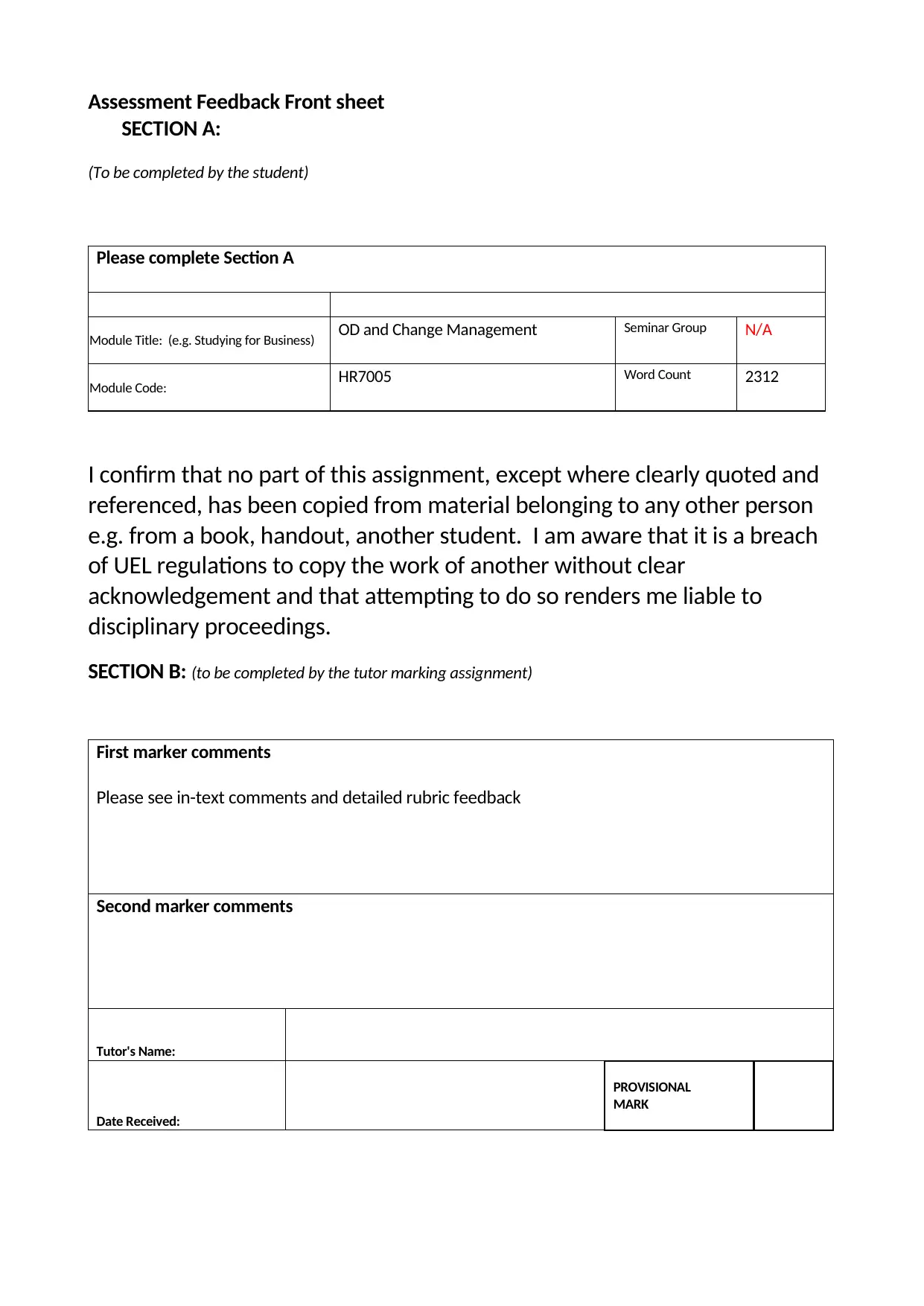
Assessment Feedback Front sheet
SECTION A:
(To be completed by the student)
Please complete Section A
Module Title: (e.g. Studying for Business) OD and Change Management Seminar Group N/A
Module Code: HR7005 Word Count 2312
I confirm that no part of this assignment, except where clearly quoted and
referenced, has been copied from material belonging to any other person
e.g. from a book, handout, another student. I am aware that it is a breach
of UEL regulations to copy the work of another without clear
acknowledgement and that attempting to do so renders me liable to
disciplinary proceedings.
SECTION B: (to be completed by the tutor marking assignment)
First marker comments
Please see in-text comments and detailed rubric feedback
Second marker comments
Tutor's Name:
Date Received:
PROVISIONAL
MARK
SECTION A:
(To be completed by the student)
Please complete Section A
Module Title: (e.g. Studying for Business) OD and Change Management Seminar Group N/A
Module Code: HR7005 Word Count 2312
I confirm that no part of this assignment, except where clearly quoted and
referenced, has been copied from material belonging to any other person
e.g. from a book, handout, another student. I am aware that it is a breach
of UEL regulations to copy the work of another without clear
acknowledgement and that attempting to do so renders me liable to
disciplinary proceedings.
SECTION B: (to be completed by the tutor marking assignment)
First marker comments
Please see in-text comments and detailed rubric feedback
Second marker comments
Tutor's Name:
Date Received:
PROVISIONAL
MARK
Paraphrase This Document
Need a fresh take? Get an instant paraphrase of this document with our AI Paraphraser
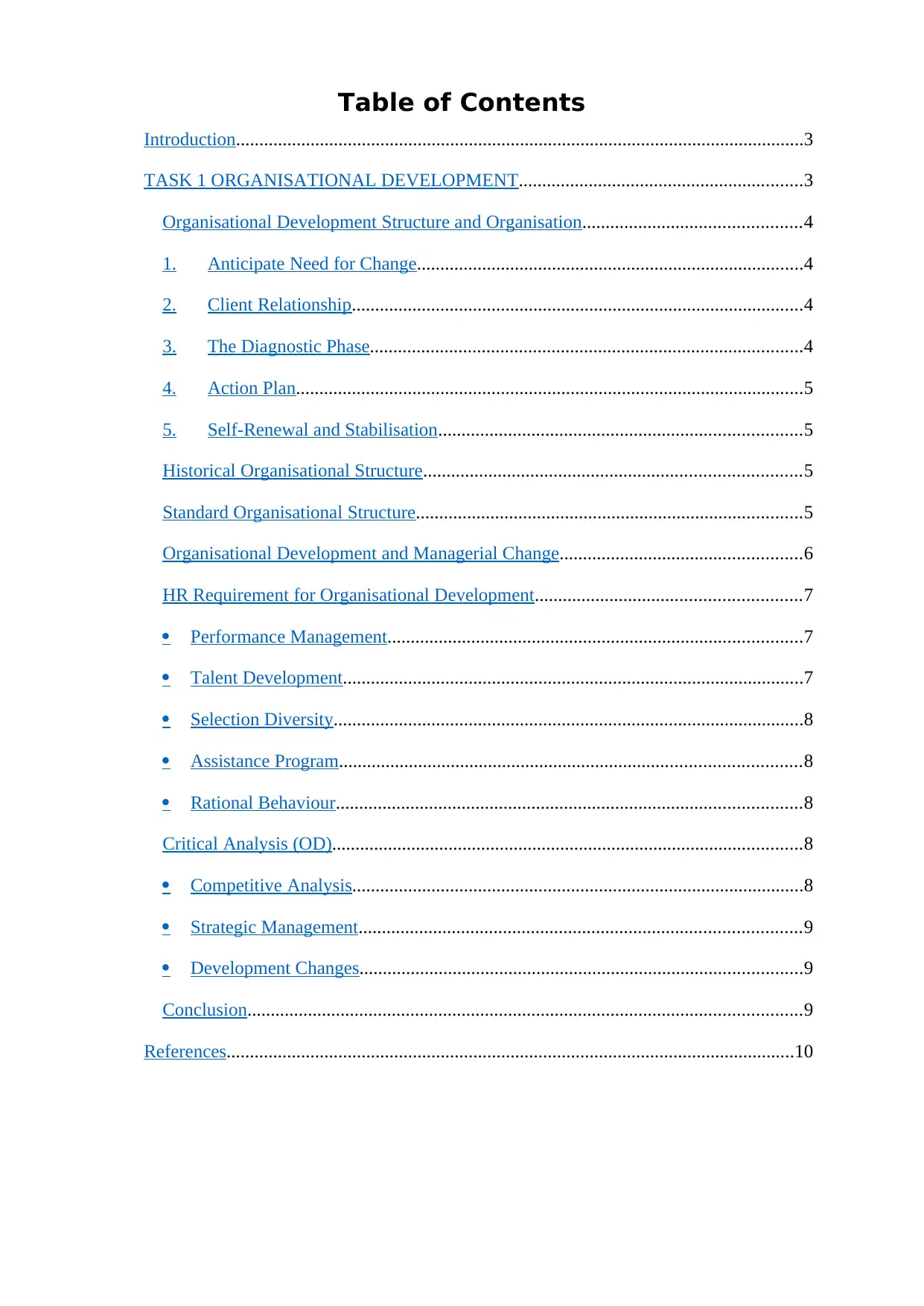
Table of Contents
Introduction..........................................................................................................................3
TASK 1 ORGANISATIONAL DEVELOPMENT.............................................................3
Organisational Development Structure and Organisation...............................................4
1. Anticipate Need for Change...................................................................................4
2. Client Relationship.................................................................................................4
3. The Diagnostic Phase.............................................................................................4
4. Action Plan.............................................................................................................5
5. Self-Renewal and Stabilisation..............................................................................5
Historical Organisational Structure.................................................................................5
Standard Organisational Structure...................................................................................5
Organisational Development and Managerial Change....................................................6
HR Requirement for Organisational Development.........................................................7
Performance Management.........................................................................................7
Talent Development...................................................................................................7
Selection Diversity.....................................................................................................8
Assistance Program...................................................................................................8
Rational Behaviour....................................................................................................8
Critical Analysis (OD).....................................................................................................8
Competitive Analysis.................................................................................................8
Strategic Management...............................................................................................9
Development Changes...............................................................................................9
Conclusion.......................................................................................................................9
References..........................................................................................................................10
Introduction..........................................................................................................................3
TASK 1 ORGANISATIONAL DEVELOPMENT.............................................................3
Organisational Development Structure and Organisation...............................................4
1. Anticipate Need for Change...................................................................................4
2. Client Relationship.................................................................................................4
3. The Diagnostic Phase.............................................................................................4
4. Action Plan.............................................................................................................5
5. Self-Renewal and Stabilisation..............................................................................5
Historical Organisational Structure.................................................................................5
Standard Organisational Structure...................................................................................5
Organisational Development and Managerial Change....................................................6
HR Requirement for Organisational Development.........................................................7
Performance Management.........................................................................................7
Talent Development...................................................................................................7
Selection Diversity.....................................................................................................8
Assistance Program...................................................................................................8
Rational Behaviour....................................................................................................8
Critical Analysis (OD).....................................................................................................8
Competitive Analysis.................................................................................................8
Strategic Management...............................................................................................9
Development Changes...............................................................................................9
Conclusion.......................................................................................................................9
References..........................................................................................................................10

Introduction
The recent times of the business development modes according to the recent time with
upgrading technologies and working force organisation also have to make some of the major
changes and have to apply some approach to resume themselves according to the time. The
organization is related to the achieving prospectus of a particular goal or objective and for achieving
those objective these have to apply some major changes according to the management and
organisational structure in terms of a complete output. These changes may help in managing the
future aspects as well for the organisation. This study will define the historical organisational
theory, current theory and the organisational management changes effects.
TASK 1
ORGANISATIONAL DEVELOPMENT
Organisational behaviour is a process in which all kind of elements related to the business
and it outcomes are clearly discussed and analysed about which will be the better mode to be
applied. It includes some relative development related to the technologies, management,
infrastructure, changes in raw material, product quality and the other aspect related to this. OD is a
process which is based on evidence structural aspects, which led the business utilise the scientific
modes related to the upgradation in goods and machineries or organisational behaviour which will
affect the input level and the outcome of the organisational development will be carried out. It is
explained in this brief effectively.
Organisational Development Structure and Organisation
Over the years, the concept of OD has changed somewhat. OD now plays a key role in
implementing the company's policies, understanding the corporate culture and shaping practices
according to the company's tasks. As the spread of OD increased, Brown developed a strategic
framework to implement the proposed changes, which was an important tool for OD employees. It
consists of the following five steps:
The recent times of the business development modes according to the recent time with
upgrading technologies and working force organisation also have to make some of the major
changes and have to apply some approach to resume themselves according to the time. The
organization is related to the achieving prospectus of a particular goal or objective and for achieving
those objective these have to apply some major changes according to the management and
organisational structure in terms of a complete output. These changes may help in managing the
future aspects as well for the organisation. This study will define the historical organisational
theory, current theory and the organisational management changes effects.
TASK 1
ORGANISATIONAL DEVELOPMENT
Organisational behaviour is a process in which all kind of elements related to the business
and it outcomes are clearly discussed and analysed about which will be the better mode to be
applied. It includes some relative development related to the technologies, management,
infrastructure, changes in raw material, product quality and the other aspect related to this. OD is a
process which is based on evidence structural aspects, which led the business utilise the scientific
modes related to the upgradation in goods and machineries or organisational behaviour which will
affect the input level and the outcome of the organisational development will be carried out. It is
explained in this brief effectively.
Organisational Development Structure and Organisation
Over the years, the concept of OD has changed somewhat. OD now plays a key role in
implementing the company's policies, understanding the corporate culture and shaping practices
according to the company's tasks. As the spread of OD increased, Brown developed a strategic
framework to implement the proposed changes, which was an important tool for OD employees. It
consists of the following five steps:
⊘ This is a preview!⊘
Do you want full access?
Subscribe today to unlock all pages.

Trusted by 1+ million students worldwide
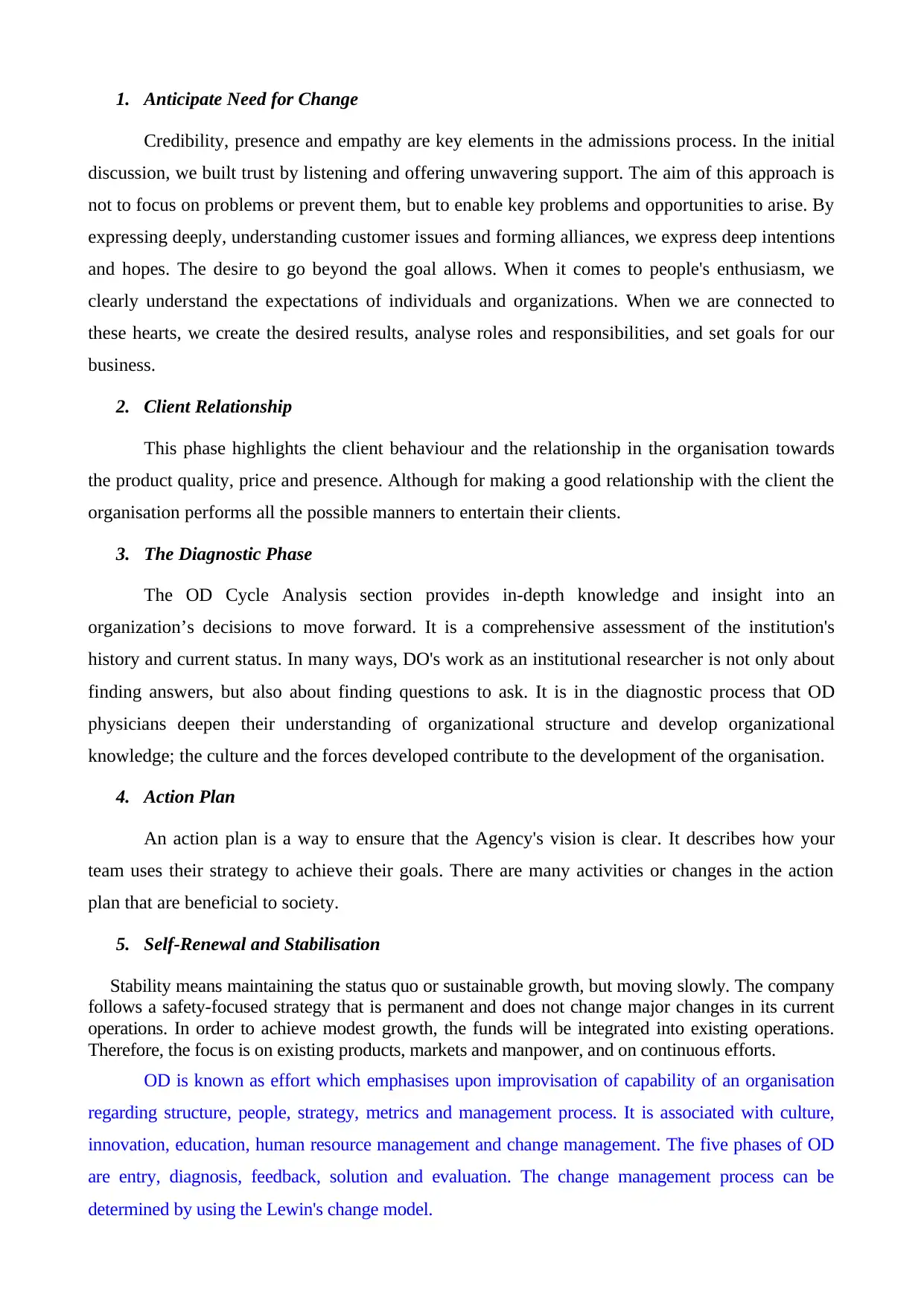
1. Anticipate Need for Change
Credibility, presence and empathy are key elements in the admissions process. In the initial
discussion, we built trust by listening and offering unwavering support. The aim of this approach is
not to focus on problems or prevent them, but to enable key problems and opportunities to arise. By
expressing deeply, understanding customer issues and forming alliances, we express deep intentions
and hopes. The desire to go beyond the goal allows. When it comes to people's enthusiasm, we
clearly understand the expectations of individuals and organizations. When we are connected to
these hearts, we create the desired results, analyse roles and responsibilities, and set goals for our
business.
2. Client Relationship
This phase highlights the client behaviour and the relationship in the organisation towards
the product quality, price and presence. Although for making a good relationship with the client the
organisation performs all the possible manners to entertain their clients.
3. The Diagnostic Phase
The OD Cycle Analysis section provides in-depth knowledge and insight into an
organization’s decisions to move forward. It is a comprehensive assessment of the institution's
history and current status. In many ways, DO's work as an institutional researcher is not only about
finding answers, but also about finding questions to ask. It is in the diagnostic process that OD
physicians deepen their understanding of organizational structure and develop organizational
knowledge; the culture and the forces developed contribute to the development of the organisation.
4. Action Plan
An action plan is a way to ensure that the Agency's vision is clear. It describes how your
team uses their strategy to achieve their goals. There are many activities or changes in the action
plan that are beneficial to society.
5. Self-Renewal and Stabilisation
Stability means maintaining the status quo or sustainable growth, but moving slowly. The company
follows a safety-focused strategy that is permanent and does not change major changes in its current
operations. In order to achieve modest growth, the funds will be integrated into existing operations.
Therefore, the focus is on existing products, markets and manpower, and on continuous efforts.
OD is known as effort which emphasises upon improvisation of capability of an organisation
regarding structure, people, strategy, metrics and management process. It is associated with culture,
innovation, education, human resource management and change management. The five phases of OD
are entry, diagnosis, feedback, solution and evaluation. The change management process can be
determined by using the Lewin's change model.
Credibility, presence and empathy are key elements in the admissions process. In the initial
discussion, we built trust by listening and offering unwavering support. The aim of this approach is
not to focus on problems or prevent them, but to enable key problems and opportunities to arise. By
expressing deeply, understanding customer issues and forming alliances, we express deep intentions
and hopes. The desire to go beyond the goal allows. When it comes to people's enthusiasm, we
clearly understand the expectations of individuals and organizations. When we are connected to
these hearts, we create the desired results, analyse roles and responsibilities, and set goals for our
business.
2. Client Relationship
This phase highlights the client behaviour and the relationship in the organisation towards
the product quality, price and presence. Although for making a good relationship with the client the
organisation performs all the possible manners to entertain their clients.
3. The Diagnostic Phase
The OD Cycle Analysis section provides in-depth knowledge and insight into an
organization’s decisions to move forward. It is a comprehensive assessment of the institution's
history and current status. In many ways, DO's work as an institutional researcher is not only about
finding answers, but also about finding questions to ask. It is in the diagnostic process that OD
physicians deepen their understanding of organizational structure and develop organizational
knowledge; the culture and the forces developed contribute to the development of the organisation.
4. Action Plan
An action plan is a way to ensure that the Agency's vision is clear. It describes how your
team uses their strategy to achieve their goals. There are many activities or changes in the action
plan that are beneficial to society.
5. Self-Renewal and Stabilisation
Stability means maintaining the status quo or sustainable growth, but moving slowly. The company
follows a safety-focused strategy that is permanent and does not change major changes in its current
operations. In order to achieve modest growth, the funds will be integrated into existing operations.
Therefore, the focus is on existing products, markets and manpower, and on continuous efforts.
OD is known as effort which emphasises upon improvisation of capability of an organisation
regarding structure, people, strategy, metrics and management process. It is associated with culture,
innovation, education, human resource management and change management. The five phases of OD
are entry, diagnosis, feedback, solution and evaluation. The change management process can be
determined by using the Lewin's change model.
Paraphrase This Document
Need a fresh take? Get an instant paraphrase of this document with our AI Paraphraser

Unfreeze - This is the preparation stage. Analyse how things work now, so you accurately
understand what needs to change to get the intended results. In this stage, you also make your
case to employees and communicate what to expect so everyone impacted is prepared. This
phase of associated with OD in the term of asking the need of change within the organisation.
This includes the reason behind new change that has to be the part of this organisation.
Change - This is the implementation phase. Put the change into practice, and keep
communicating and providing support for all employees involved. Organisational development
includes changes in structure, functioning and parameter of operations. When change
operations are conducted in an organisation then there is need to have effective processing
about business activities associated with change management. Refreeze - To avoid falling back into the old way of doing things, develop a strategy to check
in and make sure the change sticks. Review how the new processes work and measure how
well you’ve reached your goals. This includes closing different operations which were
developed while implementing the change.
Historical Organisational Structure
The historical organisational structure consists of a simple rule of management department
and organisational structure which includes only few managers of same level reporting about the
work to work task directly to the owner of the organisation. The historical structure consists of a
small departmentalization, a wide span of control, centralized authority (a single manager who deals
all the problems) and a little formalization. The decision making command was also made by the
only single manager who has to deal all kind of problems related to organisational work and the
related to the workers and output as well. This type of small organisation is difficult to run and the
guarantee is very clear. However, it is difficult to maintain such a structure in anyone other than
small organizations (Booth and Rowlinson, 2006)
Standard Organisational Structure
A standard organisation structure consists of a proper channel including all the procedures
divided in to departmentalization and all the department have their own manager. The standard
organisation can also be defined as where, the driver informs the employee, the employee will
report to the manager, the manger will report to the head manger, the head manager reports to the
Vice-President, and the Vice-President reports to senior Executive manager.
Organisational Development and Managerial Change
Organisational change and the managerial change theory are totally connected with each
other helping in changing the result of the management input and the output levels. An organization
understand what needs to change to get the intended results. In this stage, you also make your
case to employees and communicate what to expect so everyone impacted is prepared. This
phase of associated with OD in the term of asking the need of change within the organisation.
This includes the reason behind new change that has to be the part of this organisation.
Change - This is the implementation phase. Put the change into practice, and keep
communicating and providing support for all employees involved. Organisational development
includes changes in structure, functioning and parameter of operations. When change
operations are conducted in an organisation then there is need to have effective processing
about business activities associated with change management. Refreeze - To avoid falling back into the old way of doing things, develop a strategy to check
in and make sure the change sticks. Review how the new processes work and measure how
well you’ve reached your goals. This includes closing different operations which were
developed while implementing the change.
Historical Organisational Structure
The historical organisational structure consists of a simple rule of management department
and organisational structure which includes only few managers of same level reporting about the
work to work task directly to the owner of the organisation. The historical structure consists of a
small departmentalization, a wide span of control, centralized authority (a single manager who deals
all the problems) and a little formalization. The decision making command was also made by the
only single manager who has to deal all kind of problems related to organisational work and the
related to the workers and output as well. This type of small organisation is difficult to run and the
guarantee is very clear. However, it is difficult to maintain such a structure in anyone other than
small organizations (Booth and Rowlinson, 2006)
Standard Organisational Structure
A standard organisation structure consists of a proper channel including all the procedures
divided in to departmentalization and all the department have their own manager. The standard
organisation can also be defined as where, the driver informs the employee, the employee will
report to the manager, the manger will report to the head manger, the head manager reports to the
Vice-President, and the Vice-President reports to senior Executive manager.
Organisational Development and Managerial Change
Organisational change and the managerial change theory are totally connected with each
other helping in changing the result of the management input and the output levels. An organization
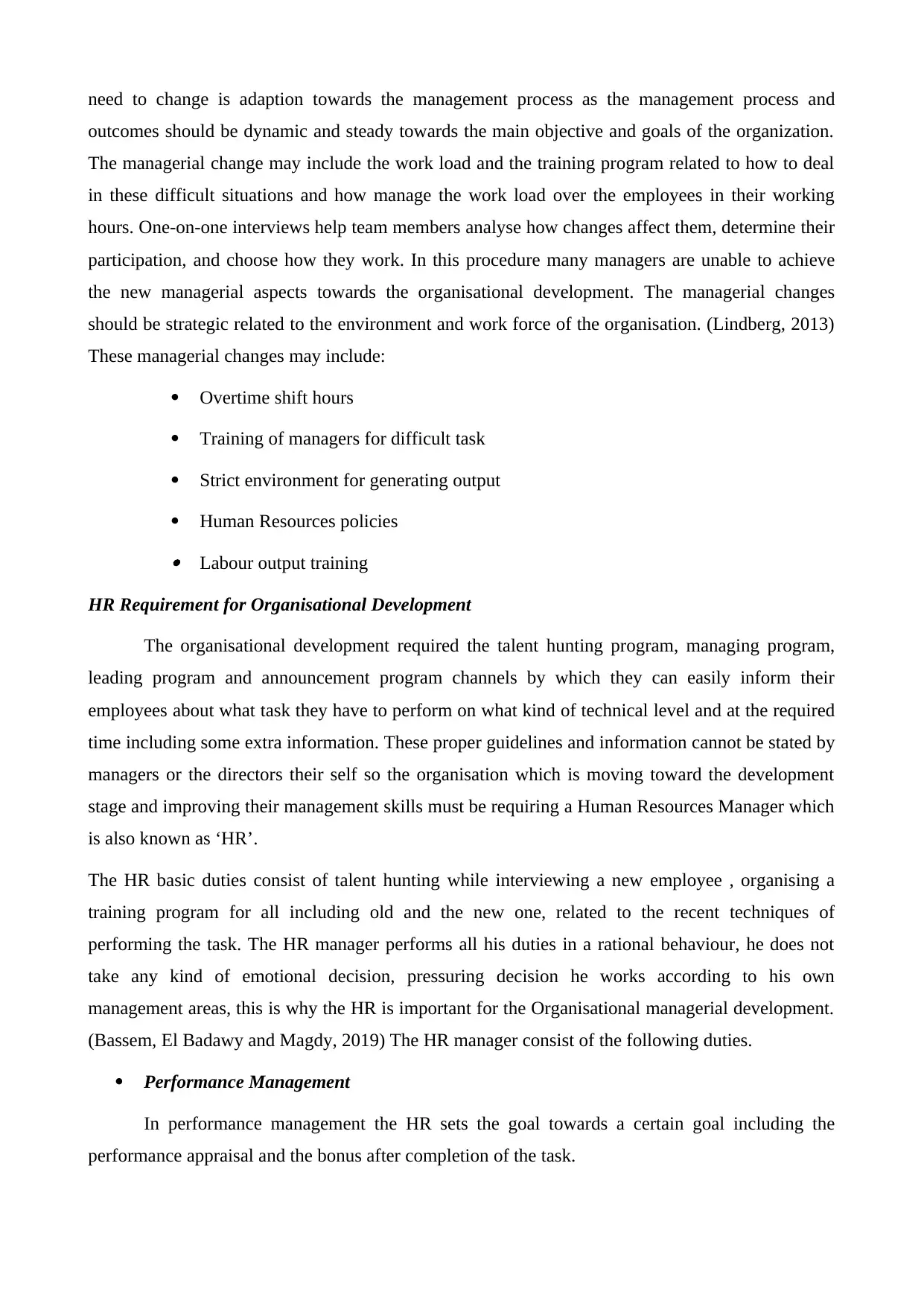
need to change is adaption towards the management process as the management process and
outcomes should be dynamic and steady towards the main objective and goals of the organization.
The managerial change may include the work load and the training program related to how to deal
in these difficult situations and how manage the work load over the employees in their working
hours. One-on-one interviews help team members analyse how changes affect them, determine their
participation, and choose how they work. In this procedure many managers are unable to achieve
the new managerial aspects towards the organisational development. The managerial changes
should be strategic related to the environment and work force of the organisation. (Lindberg, 2013)
These managerial changes may include:
Overtime shift hours
Training of managers for difficult task
Strict environment for generating output
Human Resources policies Labour output training
HR Requirement for Organisational Development
The organisational development required the talent hunting program, managing program,
leading program and announcement program channels by which they can easily inform their
employees about what task they have to perform on what kind of technical level and at the required
time including some extra information. These proper guidelines and information cannot be stated by
managers or the directors their self so the organisation which is moving toward the development
stage and improving their management skills must be requiring a Human Resources Manager which
is also known as ‘HR’.
The HR basic duties consist of talent hunting while interviewing a new employee , organising a
training program for all including old and the new one, related to the recent techniques of
performing the task. The HR manager performs all his duties in a rational behaviour, he does not
take any kind of emotional decision, pressuring decision he works according to his own
management areas, this is why the HR is important for the Organisational managerial development.
(Bassem, El Badawy and Magdy, 2019) The HR manager consist of the following duties.
Performance Management
In performance management the HR sets the goal towards a certain goal including the
performance appraisal and the bonus after completion of the task.
outcomes should be dynamic and steady towards the main objective and goals of the organization.
The managerial change may include the work load and the training program related to how to deal
in these difficult situations and how manage the work load over the employees in their working
hours. One-on-one interviews help team members analyse how changes affect them, determine their
participation, and choose how they work. In this procedure many managers are unable to achieve
the new managerial aspects towards the organisational development. The managerial changes
should be strategic related to the environment and work force of the organisation. (Lindberg, 2013)
These managerial changes may include:
Overtime shift hours
Training of managers for difficult task
Strict environment for generating output
Human Resources policies Labour output training
HR Requirement for Organisational Development
The organisational development required the talent hunting program, managing program,
leading program and announcement program channels by which they can easily inform their
employees about what task they have to perform on what kind of technical level and at the required
time including some extra information. These proper guidelines and information cannot be stated by
managers or the directors their self so the organisation which is moving toward the development
stage and improving their management skills must be requiring a Human Resources Manager which
is also known as ‘HR’.
The HR basic duties consist of talent hunting while interviewing a new employee , organising a
training program for all including old and the new one, related to the recent techniques of
performing the task. The HR manager performs all his duties in a rational behaviour, he does not
take any kind of emotional decision, pressuring decision he works according to his own
management areas, this is why the HR is important for the Organisational managerial development.
(Bassem, El Badawy and Magdy, 2019) The HR manager consist of the following duties.
Performance Management
In performance management the HR sets the goal towards a certain goal including the
performance appraisal and the bonus after completion of the task.
⊘ This is a preview!⊘
Do you want full access?
Subscribe today to unlock all pages.

Trusted by 1+ million students worldwide
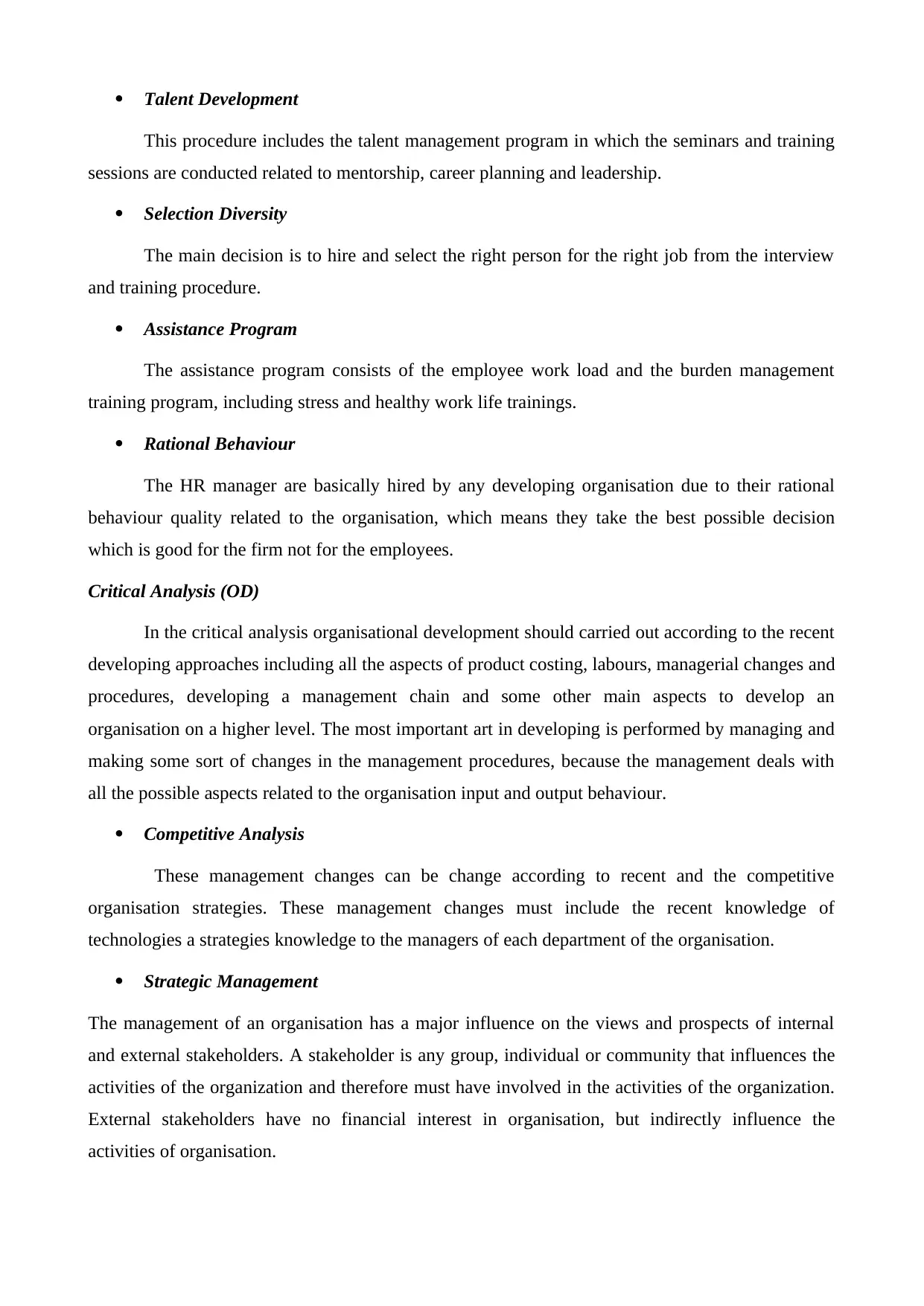
Talent Development
This procedure includes the talent management program in which the seminars and training
sessions are conducted related to mentorship, career planning and leadership.
Selection Diversity
The main decision is to hire and select the right person for the right job from the interview
and training procedure.
Assistance Program
The assistance program consists of the employee work load and the burden management
training program, including stress and healthy work life trainings.
Rational Behaviour
The HR manager are basically hired by any developing organisation due to their rational
behaviour quality related to the organisation, which means they take the best possible decision
which is good for the firm not for the employees.
Critical Analysis (OD)
In the critical analysis organisational development should carried out according to the recent
developing approaches including all the aspects of product costing, labours, managerial changes and
procedures, developing a management chain and some other main aspects to develop an
organisation on a higher level. The most important art in developing is performed by managing and
making some sort of changes in the management procedures, because the management deals with
all the possible aspects related to the organisation input and output behaviour.
Competitive Analysis
These management changes can be change according to recent and the competitive
organisation strategies. These management changes must include the recent knowledge of
technologies a strategies knowledge to the managers of each department of the organisation.
Strategic Management
The management of an organisation has a major influence on the views and prospects of internal
and external stakeholders. A stakeholder is any group, individual or community that influences the
activities of the organization and therefore must have involved in the activities of the organization.
External stakeholders have no financial interest in organisation, but indirectly influence the
activities of organisation.
This procedure includes the talent management program in which the seminars and training
sessions are conducted related to mentorship, career planning and leadership.
Selection Diversity
The main decision is to hire and select the right person for the right job from the interview
and training procedure.
Assistance Program
The assistance program consists of the employee work load and the burden management
training program, including stress and healthy work life trainings.
Rational Behaviour
The HR manager are basically hired by any developing organisation due to their rational
behaviour quality related to the organisation, which means they take the best possible decision
which is good for the firm not for the employees.
Critical Analysis (OD)
In the critical analysis organisational development should carried out according to the recent
developing approaches including all the aspects of product costing, labours, managerial changes and
procedures, developing a management chain and some other main aspects to develop an
organisation on a higher level. The most important art in developing is performed by managing and
making some sort of changes in the management procedures, because the management deals with
all the possible aspects related to the organisation input and output behaviour.
Competitive Analysis
These management changes can be change according to recent and the competitive
organisation strategies. These management changes must include the recent knowledge of
technologies a strategies knowledge to the managers of each department of the organisation.
Strategic Management
The management of an organisation has a major influence on the views and prospects of internal
and external stakeholders. A stakeholder is any group, individual or community that influences the
activities of the organization and therefore must have involved in the activities of the organization.
External stakeholders have no financial interest in organisation, but indirectly influence the
activities of organisation.
Paraphrase This Document
Need a fresh take? Get an instant paraphrase of this document with our AI Paraphraser
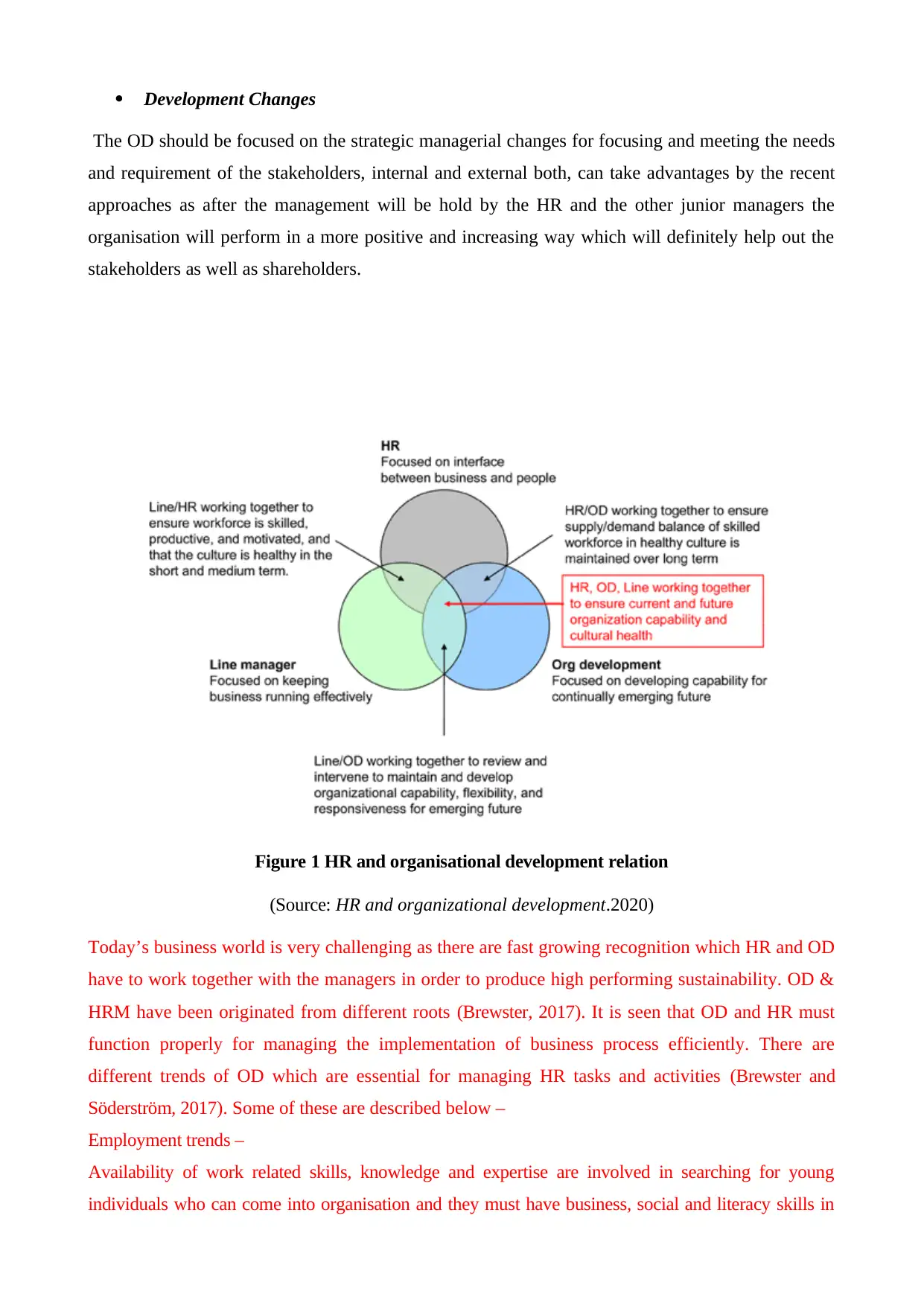
Development Changes
The OD should be focused on the strategic managerial changes for focusing and meeting the needs
and requirement of the stakeholders, internal and external both, can take advantages by the recent
approaches as after the management will be hold by the HR and the other junior managers the
organisation will perform in a more positive and increasing way which will definitely help out the
stakeholders as well as shareholders.
Figure 1 HR and organisational development relation
(Source: HR and organizational development.2020)
Today’s business world is very challenging as there are fast growing recognition which HR and OD
have to work together with the managers in order to produce high performing sustainability. OD &
HRM have been originated from different roots (Brewster, 2017). It is seen that OD and HR must
function properly for managing the implementation of business process efficiently. There are
different trends of OD which are essential for managing HR tasks and activities (Brewster and
Söderström, 2017). Some of these are described below –
Employment trends –
Availability of work related skills, knowledge and expertise are involved in searching for young
individuals who can come into organisation and they must have business, social and literacy skills in
The OD should be focused on the strategic managerial changes for focusing and meeting the needs
and requirement of the stakeholders, internal and external both, can take advantages by the recent
approaches as after the management will be hold by the HR and the other junior managers the
organisation will perform in a more positive and increasing way which will definitely help out the
stakeholders as well as shareholders.
Figure 1 HR and organisational development relation
(Source: HR and organizational development.2020)
Today’s business world is very challenging as there are fast growing recognition which HR and OD
have to work together with the managers in order to produce high performing sustainability. OD &
HRM have been originated from different roots (Brewster, 2017). It is seen that OD and HR must
function properly for managing the implementation of business process efficiently. There are
different trends of OD which are essential for managing HR tasks and activities (Brewster and
Söderström, 2017). Some of these are described below –
Employment trends –
Availability of work related skills, knowledge and expertise are involved in searching for young
individuals who can come into organisation and they must have business, social and literacy skills in
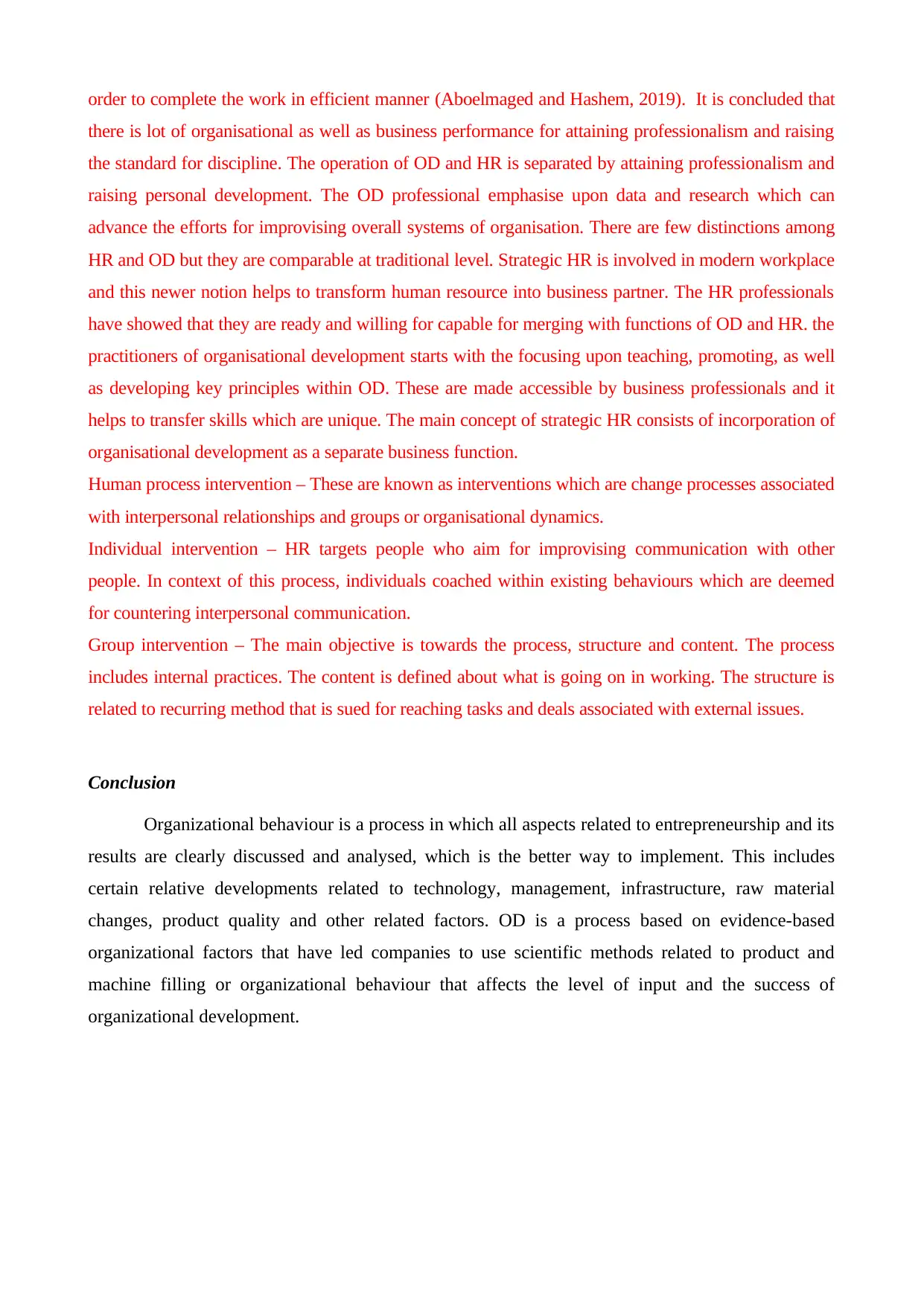
order to complete the work in efficient manner (Aboelmaged and Hashem, 2019). It is concluded that
there is lot of organisational as well as business performance for attaining professionalism and raising
the standard for discipline. The operation of OD and HR is separated by attaining professionalism and
raising personal development. The OD professional emphasise upon data and research which can
advance the efforts for improvising overall systems of organisation. There are few distinctions among
HR and OD but they are comparable at traditional level. Strategic HR is involved in modern workplace
and this newer notion helps to transform human resource into business partner. The HR professionals
have showed that they are ready and willing for capable for merging with functions of OD and HR. the
practitioners of organisational development starts with the focusing upon teaching, promoting, as well
as developing key principles within OD. These are made accessible by business professionals and it
helps to transfer skills which are unique. The main concept of strategic HR consists of incorporation of
organisational development as a separate business function.
Human process intervention – These are known as interventions which are change processes associated
with interpersonal relationships and groups or organisational dynamics.
Individual intervention – HR targets people who aim for improvising communication with other
people. In context of this process, individuals coached within existing behaviours which are deemed
for countering interpersonal communication.
Group intervention – The main objective is towards the process, structure and content. The process
includes internal practices. The content is defined about what is going on in working. The structure is
related to recurring method that is sued for reaching tasks and deals associated with external issues.
Conclusion
Organizational behaviour is a process in which all aspects related to entrepreneurship and its
results are clearly discussed and analysed, which is the better way to implement. This includes
certain relative developments related to technology, management, infrastructure, raw material
changes, product quality and other related factors. OD is a process based on evidence-based
organizational factors that have led companies to use scientific methods related to product and
machine filling or organizational behaviour that affects the level of input and the success of
organizational development.
there is lot of organisational as well as business performance for attaining professionalism and raising
the standard for discipline. The operation of OD and HR is separated by attaining professionalism and
raising personal development. The OD professional emphasise upon data and research which can
advance the efforts for improvising overall systems of organisation. There are few distinctions among
HR and OD but they are comparable at traditional level. Strategic HR is involved in modern workplace
and this newer notion helps to transform human resource into business partner. The HR professionals
have showed that they are ready and willing for capable for merging with functions of OD and HR. the
practitioners of organisational development starts with the focusing upon teaching, promoting, as well
as developing key principles within OD. These are made accessible by business professionals and it
helps to transfer skills which are unique. The main concept of strategic HR consists of incorporation of
organisational development as a separate business function.
Human process intervention – These are known as interventions which are change processes associated
with interpersonal relationships and groups or organisational dynamics.
Individual intervention – HR targets people who aim for improvising communication with other
people. In context of this process, individuals coached within existing behaviours which are deemed
for countering interpersonal communication.
Group intervention – The main objective is towards the process, structure and content. The process
includes internal practices. The content is defined about what is going on in working. The structure is
related to recurring method that is sued for reaching tasks and deals associated with external issues.
Conclusion
Organizational behaviour is a process in which all aspects related to entrepreneurship and its
results are clearly discussed and analysed, which is the better way to implement. This includes
certain relative developments related to technology, management, infrastructure, raw material
changes, product quality and other related factors. OD is a process based on evidence-based
organizational factors that have led companies to use scientific methods related to product and
machine filling or organizational behaviour that affects the level of input and the success of
organizational development.
⊘ This is a preview!⊘
Do you want full access?
Subscribe today to unlock all pages.

Trusted by 1+ million students worldwide
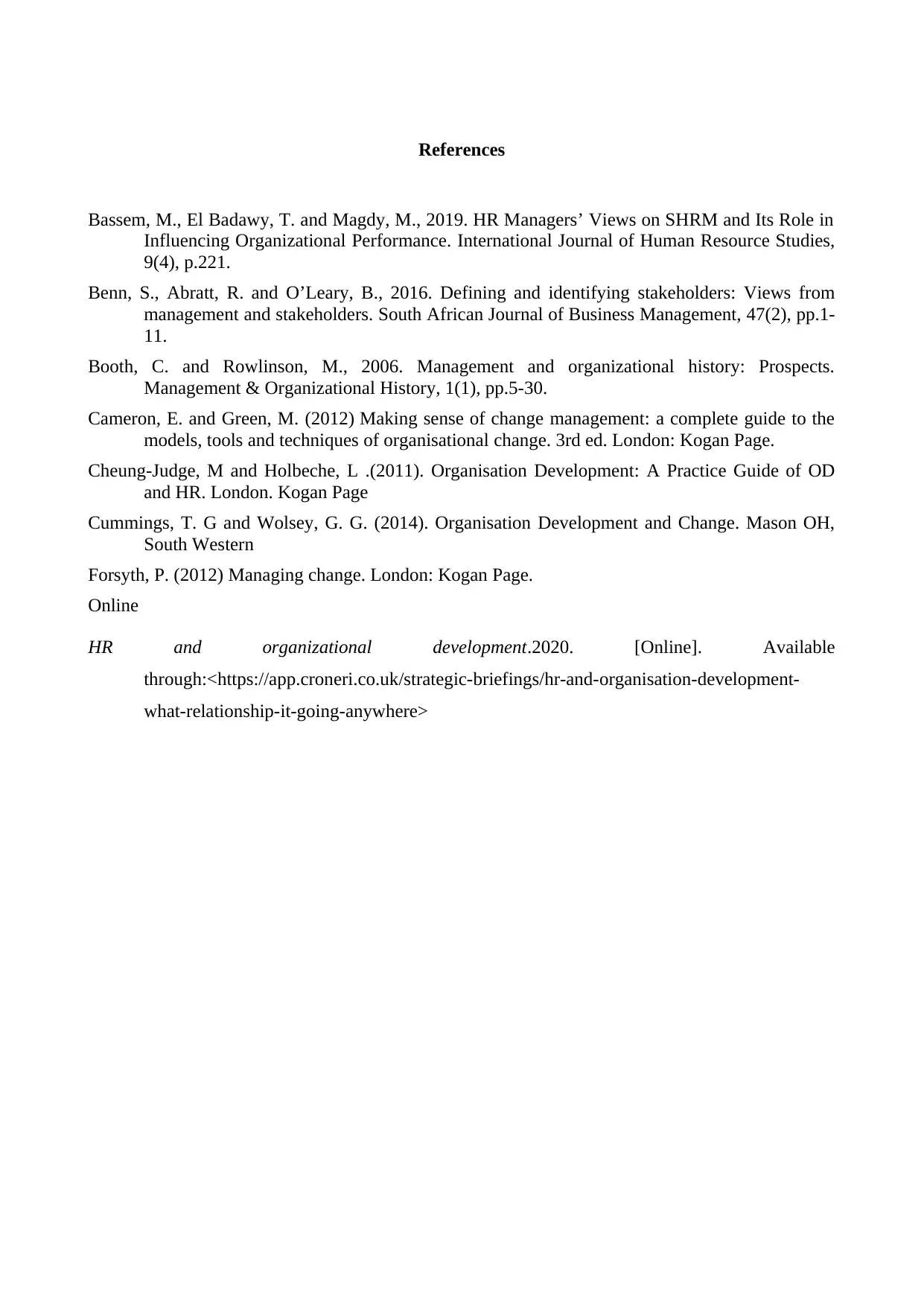
References
Bassem, M., El Badawy, T. and Magdy, M., 2019. HR Managers’ Views on SHRM and Its Role in
Influencing Organizational Performance. International Journal of Human Resource Studies,
9(4), p.221.
Benn, S., Abratt, R. and O’Leary, B., 2016. Defining and identifying stakeholders: Views from
management and stakeholders. South African Journal of Business Management, 47(2), pp.1-
11.
Booth, C. and Rowlinson, M., 2006. Management and organizational history: Prospects.
Management & Organizational History, 1(1), pp.5-30.
Cameron, E. and Green, M. (2012) Making sense of change management: a complete guide to the
models, tools and techniques of organisational change. 3rd ed. London: Kogan Page.
Cheung-Judge, M and Holbeche, L .(2011). Organisation Development: A Practice Guide of OD
and HR. London. Kogan Page
Cummings, T. G and Wolsey, G. G. (2014). Organisation Development and Change. Mason OH,
South Western
Forsyth, P. (2012) Managing change. London: Kogan Page.
Online
HR and organizational development.2020. [Online]. Available
through:<https://app.croneri.co.uk/strategic-briefings/hr-and-organisation-development-
what-relationship-it-going-anywhere>
Bassem, M., El Badawy, T. and Magdy, M., 2019. HR Managers’ Views on SHRM and Its Role in
Influencing Organizational Performance. International Journal of Human Resource Studies,
9(4), p.221.
Benn, S., Abratt, R. and O’Leary, B., 2016. Defining and identifying stakeholders: Views from
management and stakeholders. South African Journal of Business Management, 47(2), pp.1-
11.
Booth, C. and Rowlinson, M., 2006. Management and organizational history: Prospects.
Management & Organizational History, 1(1), pp.5-30.
Cameron, E. and Green, M. (2012) Making sense of change management: a complete guide to the
models, tools and techniques of organisational change. 3rd ed. London: Kogan Page.
Cheung-Judge, M and Holbeche, L .(2011). Organisation Development: A Practice Guide of OD
and HR. London. Kogan Page
Cummings, T. G and Wolsey, G. G. (2014). Organisation Development and Change. Mason OH,
South Western
Forsyth, P. (2012) Managing change. London: Kogan Page.
Online
HR and organizational development.2020. [Online]. Available
through:<https://app.croneri.co.uk/strategic-briefings/hr-and-organisation-development-
what-relationship-it-going-anywhere>
1 out of 10
Related Documents
Your All-in-One AI-Powered Toolkit for Academic Success.
+13062052269
info@desklib.com
Available 24*7 on WhatsApp / Email
![[object Object]](/_next/static/media/star-bottom.7253800d.svg)
Unlock your academic potential
Copyright © 2020–2025 A2Z Services. All Rights Reserved. Developed and managed by ZUCOL.





